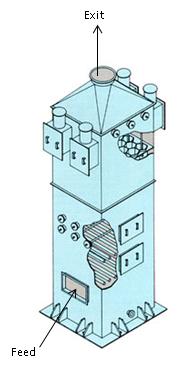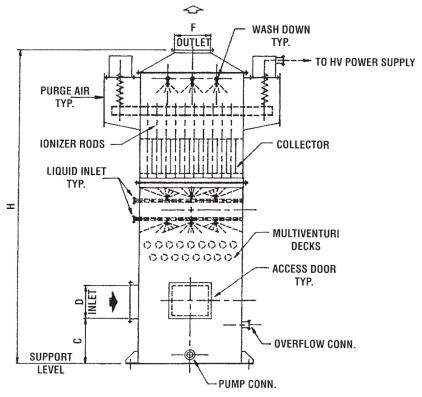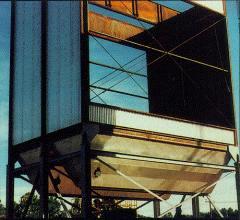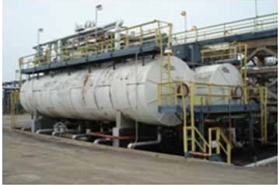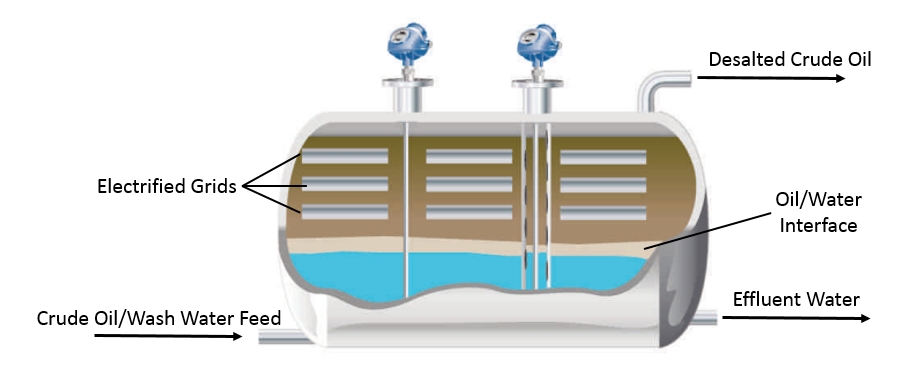Electrostatic precipitators are used to separate small particles, 1 micron or smaller, from gas streams. This process is also used in desalters to separate salts and sediment from crude oil feeds.
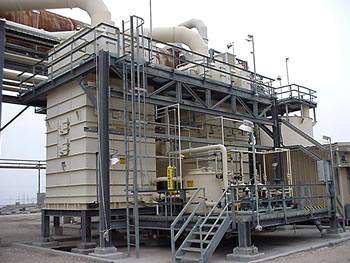
General Information
Electrostatic precipitators, such as the one shown here, work by exposing particles in the feed stream to an electrostatic field. The particles are small and easily collect a charge. The charged particles are then collected and removed by collectors that are oppositely charged.
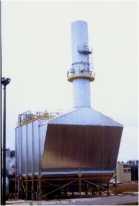
The collectors get covered with particles and are cleaned off periodically. The particles are generally discarded but can be further processed if profitable.
Electrostatic precipitators can collect a variety of particles from a gas stream. The table below shows the wide range of collection sizes in gas streams, from as small as x-rays and smog to as large as fly ash and pulverized coal.

Electrostatic precipitators can be designed for horizontal flow or vertical flow. The schematic below shows a vertical flow electrostatic precipitator. The feed gas enters near the bottom and rises to the top. As it enters, the stream passes electrodes creating an electric field that gives the particles a charge, usually negative. When the stream reaches the collectors, the particles are attracted to the grounded surface that is oppositely charged. The collector can take one of four shapes: parallel, round, hexagonal, or square. Each design has its tradeoffs in terms of space requirements, collection surface, power intensity, and maintenance. The feed stream, now free of particles, exits out the top of the precipitator. Electrostatic precipitators usually have efficiencies of greater than 99%.
In addition to horizontal versus vertical flow, electrostatic precipitators include wet and dry precipitators. A third, specialized type of electrostatic precipitator is a desalter, which removes salts and sediment from crude oil streams.
Equipment Design
(Copyright Clean Gas Systems, Inc., Hauppauge, NY)
Wet Electrostatic Precipitators
In wet electrostatic precipitators, charged particles (green) are collected onto the collectors as seen in the animation here. As the particles accumulate on the collector, a liquid (blue), typically water, runs down the plates. The water collects and removes the particles from the plates.
Dry Electrostatic Precipitators
Dry electrostatic precipitators clean the collecting plates in a different manner, as can be seen in the animation below. As the particles (green) accumulate, the collectors are rapped, causing the particles to fall. During rapping, usually, a hammer or other similar device delivers a blow to the collector at an intensity and frequency determined by the properties of the collected material. A vertical shock wave is created that causes the collected material to fall down the precipitator. These particles are collected in large hoppers at the bottom of the precipitator.
Hoppers are used mainly for material handling as storage, transport, and feeders. The hoppers used in precipitators, such as the one shown below, collect and store particles that can be further processed. For more information, see the Hoppers section of the encyclopedia.
(Copyright PPC Air Pollution Control, Longview, TX)
Desalters
Desalters have a slightly different function and equipment design, containing electrified grids. The feed is raw crude oil, which is mixed with wash water before entering the desalter. This mix creates an emulsion containing fine droplets of immiscible liquids. The wash water absorbs most of the salt from the crude oil feed. In the desalter, the emulsion feed separates into an oil phase, an emulsion of water and oil, and a water phase containing dissolved salts. The electrified grids promote further separation of salt from crude oil and the coalescence of water droplets containing the salt from the crude oil feed. The water and desalted oil are separated by gravity and immiscibility into the product streams. A schematic for this process is shown below.
(Copyright Emerson Process Management, Chanhassen, MN)
Usage Examples
Electrostatic precipitators are used in a variety of industries for emission reduction of particles to control air pollution. The picture shown below is a refinery boiler that has a wet electrostatic precipitator installed for the treatment of flue gas emissions. Electrostatic precipitation is also used in the desalination of crude oil by using a desalter. This desalination is necessary to avoid corrosion from acids formed by salts in downstream oil refinement equipment.

Shown here are two examples of precipitators used in particle emission reduction. The picture on the left shows a dry electrostatic precipitator used in the boiling and drying processes. The wet electrostatic precipitator on the right is used to treat fryer vent exhaust in the food processing industry.
(Pictures copyright PPC Air Pollution Control, Longview, TX)
Advantages
- High efficiency (99%) particle removal.
- Collected particles can be recovered for subsequent processing.
- Low-pressure drop.
Disadvantages
- Clogging can occur.
- Safety concerns with high voltage electrodes.
- Large space requirements.
- Safety concerns with volatile organic contaminants in wastewater systems for desalters
Acknowledgements
- Clean Gas Systems, Inc., Hauppauge, NY
- PPC Air Pollution Control, Longview, TX
- Emerson Process Management, Chanhassen, MN
References
- “Desalter Interface Control.” Agar Corporation: Process Measurement & Control Solutions. N.p., n.d. Web. 23 Nov. 2015.
- Kirk-Othmer. Concise Encyclopedia of Chemical Technology 4th ed. New York: John Wiley & Sons, Inc., 1999. Print.
- Perry, Robert H., and Don W. Green. Perry’s Chemical Engineers’ Handbook, 7th ed. New York: McGraw Hill, 1997: 25-5; 25-8; 25-22 – 25-57. Print.
- Arnold, Ken, and Maurice Stewart. “Chapter 7 – Crude Oil Treating and Oil Desalting Systems.” Surface Production Operations. Amsterdam: Elsevier, 2008. 351-456. Print.
Developers
- Chris Seadeek
- Christy Charlton
- Kelsey Kaplan
- Nathan Hoffman

